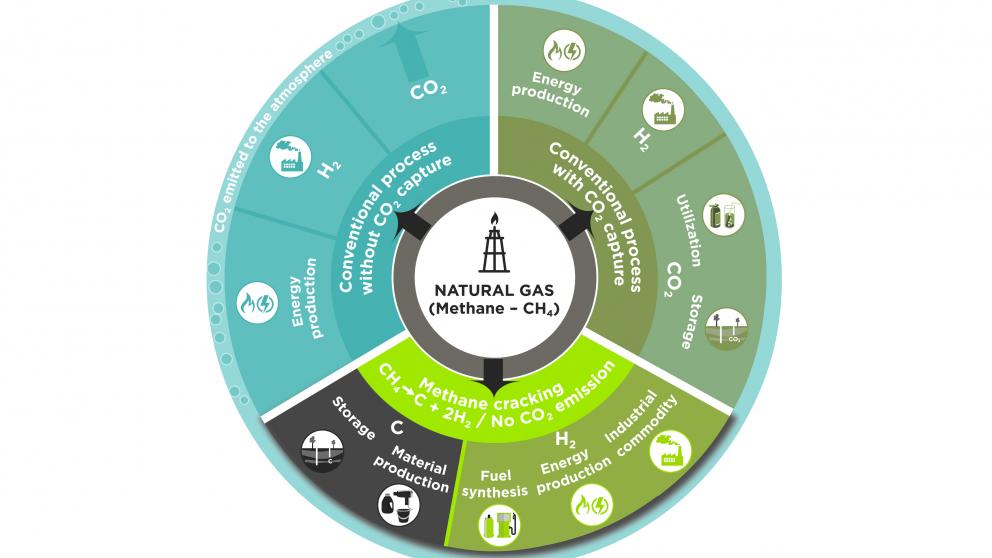Methane Decarbonisation
Duration

In the medium to long term, fossil fuels and natural gas in particular will continue to play an important role in our energy mix. There is therefore a need for innovative solutions to mitigate their environmental impact. Adaptation measures like Carbon Capture and Sequestration (CCS) are insufficient, since the underground storage of carbon dioxide raises many technical and safety concerns. In a promising alternative, the energy potential of natural gas could be exploited without incurring CO2 emissions by extracting hydrogen from the thermal splitting of methane in a process known as ‘methane cracking’.
Project aim and results:
This project investigated the CO2-free production of hydrogen from natural gas through the high-temperature dissociation of methane (CH4) into hydrogen (H) and solid black carbon (C). Carbon is an industrial commodity of growing importance; the same applies for hydrogen, which is as well a promising energy vector whose demand is expected to increase in the future.
Together with the Karlsruhe Institute of Technology (KIT) as the main partner, and with contributions from the Leibnitz Institute for Catalysis at the University of Rostock (LIKAT) and RWTH Aachen University, the project made considerable progress in the development of this technology. The feasibility of ‘methane cracking’ had already been demonstrated in several experiments, and the IASS project is building on these results to develop an industrially viable process.
We are examining key technological aspects including the use of catalysts (metallic or carbonaceous) in liquid metals, coke-removal systems, bubbling dynamics and reaction kinetics. A bubble column reactor with molten metal has been designed that can facilitate the separation of the reaction products and enable continuous operation. In collaboration with the Karlsruhe Institute of Technology (KIT), we also built a prototype reactor. The first test runs were completed in 2013, and further tests were carried out in 2014 to confirm qualitative results for hydrogen conversion rates. Significant breakthroughs were made in the second half of 2014, when experiments proved that high-quality carbon (i.e., suitable for industrial use) could be efficiently produced at temperatures above 800°C. On that basis, we have identified a final set-up that relies on tin as the liquid metal of choice and on relatively inexpensive and easy-to-handle materials for the reactor.
The environmental impact and economic feasibility of the proposed industrial-scale methane cracking process can be considered very positive, strengthening the case for further research and development.
Project members
Prof. Alberto Abánades (Project Leader, 01.2011–12.2016)
Prof. Carlo Rubbia (01.2011–12.2016)
Dr. Stefan Stückrad (10.2011–12.2016)
Dr. Horst Wenninger (08.2013–12.2016)
Dr. Renu Kumar Rathnam (01.2014–03.2016)
Dr. Kian Mehravaran (07.2013–12.2015)
Dr. Ali Ghannadzadeh (11.2012–02.2014)
Dr. Camillo Falco (07.2012–09.2013)
Selected Publications:
A. Abánades, C. Rubbia, D. Salmieri, Thermal cracking of methane into Hydrogen for a CO2-free utilization of natural gas, International Journal of Hydrogen Energy, Volume 38, Issue 20, 9 July 2013, Pages 8491-8496.
A. Abánades, C. Rubbia, D. Salmieri, Technological challenges for industrial development of hydrogen production based on methane cracking, Energy, Volume 46, Issue 1, October 2012, Pages 359-363.
M. Plevan, T. Geißler, A. Abánades, K. Mehravaran, R.K. Rathnam, C. Rubbia, D. Salmieri, L. Stoppel, S. Stückrad, Th. Wetzel, Thermal cracking of methane in a liquid metal bubble column reactor: Experiments and kinetic analysis, International Journal of Hydrogen Energy, Volume 40, Issue 25, 6 July 2015, Pages 8020-8033.
T. Geißler, M. Plevan, A. Abánades, A. Heinzel, K. Mehravaran, R.K. Rathnam, C. Rubbia, D. Salmieri, L. Stoppel, S. Stückrad, A. Weisenburger, H. Wenninger, Th. Wetzel, Experimental investigation and thermo-chemical modeling of methane pyrolysis in a liquid metal bubble column reactor with a packed bed, International Journal of Hydrogen Energy, Volume 40, Issue 41, 2 November 2015, Pages 14134-14146.